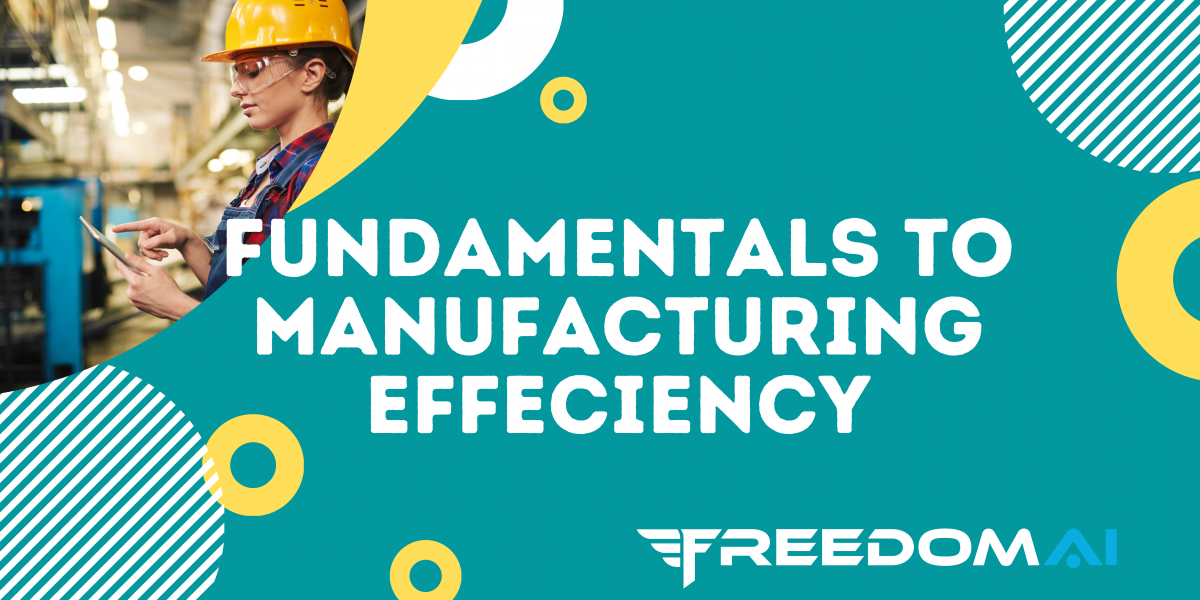Improving Efficiency in Manufacturing
As manufacturers, you are always looking to improve efficiency. There can be many different ways for manufacturers to increase their overall production speed through the utilization of new technology. Whether it is improving communication between machines or automating processes with robotics, many areas need improvement to achieve greater efficiency in manufacturing.
Functional excellence is not enough to stay competitive in today’s manufacturing landscape. Maintaining a profitable, competitive, and sustainable business today requires that organizations achieve efficiencies across each stage of the value stream. Achieving greater efficiencies in manufacturing, however, can be challenged by various factors, including a growing competitive marketplace, shifting customer demand, rapid introduction of new technologies, rising raw material costs, diminishing manufacturing expertise, and organizational, cultural, and process change management obstacles.
While these are not new challenges, manufacturers must address and overcome them to stay competitive. Legacy approaches to production management focused on linear, localized optimizations are no longer suitable. Instead, companies must establish a holistic strategy of flexible, adaptive, interlinked production and operations systems. The strategy must focus on five fundamental keys to manufacturing efficiency—what we call the “5M’s of Efficiency.”
5M’s to Greater Efficiency in Manufacturing
1. Man: Engage Employees
Fostering a high level of individual worker knowledge, enthusiasm, and motivation produces employees who contribute value to the processes and standards around them, boosting productivity and efficiency in each operational stage.
However, what workers bring to the table is only half the equation. The second half of the equation is that your employees must be supplied with the correct information to get the job done correctly. They need access to information that is accurate, up to date, and that is the same as their co-workers. If your employees are not working with good data or on the same page with each other, manufacturing efficiency will never happen. If information is not distributed promptly, management might not make vital decisions until too much time has passed for factory workers to take advantage of a specific window of opportunity.
Workers need to know when there’s a problem on the shop floor and where it is. If they are unaware of a stoppage or can’t find the source of a problem, valuable time can be squandered, and money can be lost. Triggered alerts with detailed information that go directly to the appropriate employee can keep an event from creating a significant dent in your workflow.
2. Materials: Cost-Effective & High Quality
Good materials make great products. Attention to your manufacturing process’s quality, cleanliness, performance, and environmental efficiency can have impressive results. Sound material choices, prevention of workpiece contamination, reduced use of consumables, incorporation of superior precision tooling, and clean and healthy environments inside and outside of an organization contribute to the efficiency of manufacturing processes.
If poor materials are used, deficient products crop up more often, requiring extra runs to make your quota. Customers unhappy with their product will cause a strain on other parts of your business such as customer service, which could have been prevented if the right material had been used from the start.
Not only is material an important consideration for the final product but so is what the material does while it is in your possession. Is it difficult to transport? What precautions are required to work with it? Does it move through the process quickly? What steps are needed to store it safely? What’s required to dispose of it? If a material is too wasteful, dangerous, or makes a mess, this may not be the best choice for your process.
3. Machine: Reduce Errors & Inefficiencies
Efficient machines increase overall plant productivity. Design, install, and maintain durable, accurate machines reduce waste, save money, create more precise products, and increase overall plant productivity. Work-holding systems ensure greater precision and increased tool life. Application engineering solutions incorporate careful measurement and research with detailed knowledge of the available technology to design efficient manufacturing applications.
Just because a machine has a significant amount of historical runtime against it, doesn’t mean it can’t still get the job done. With specialized adapters and appliances, legacy machines can find renewed purpose and start to provide crucial data that can give you the visibility to ensure your legacy equipment is operating at expected levels and allows you to keep up with the demand within your workflow. If you can continue to use the same assets because you have found hidden capacity by improving your asset utilization, that’s a victory for your cost control, asset life management, and overall facility productivity.
Also, don’t let your mind be swayed whether you have a large number of machines or just a few. The right machine working the right way can provide a big return on your investment. Devices that don’t produce the desired results can quickly drag down your business. If even one asset is experiencing more downtime than in-cycle time, production lags and delays can add up to much wasted time and money. Getting more from your shop floor equipment is essential to manufacturers of all sizes and industries.
4. Methods: Plan, Organize, Execute
Carefully designed, state-of-the-art smart manufacturing methods and processes boost plant efficiency. Utilizing the latest solutions and strategies in production management—from error-proofing techniques to automated asset monitoring, Statistical Process Control (SPC) and Failure Mode Effect Analysis (FMEA)—helps create a leaner, more efficient production environment.
Also, don’t disregard time-tested methods from history when exploring the latest methods in green manufacturing. How an asset or facility performed five years, three years, one year, or even six months ago can reveal trends and provide a “big picture” view of your manufacturing history. This bigger picture can reveal where process or tools changes must be made to increase efficiencies moving forward.
Manual operations do not have to be discarded to create an efficient workflow. Robotics or CNC machines can be on the same information extraction system as welding stations, painting booths, old pneumatic presses, or even ancient industrial ovens. Utilizing various sensors, those processes and assets can be measured regardless of brand or age. Integrating system-wide data collected from physical, operational, and human assets drives efficiency and agility. This reduces production downtime and improves a manufacturer’s ability to predict and avoid potential failures and adjust to changes in demand.
An overlooked aspect of improving operations is the transition rate. If it takes several weeks or even months to implement a machine monitoring solution to ensure the correct method is in place, the consequences could be severe to your bottom line. From a site survey to the installation of hardware to software installs to training, all this must be considered when creating a new workflow or integrating smart manufacturing procedures.
5. Money: Increase Profitability with Better Measurement
In business, everything boils down to money. The only way to determine if you are making it or losing it is with data. Meaningful metrics increase profitability. Comprehensive, real-time data collection and statistical analysis of processes, machines, and other assets are critical to maintaining maximum efficiency of operations and budgets. Consistent monitoring of each asset’s availability, performance, and quality facilitates the improvement of operational efficiency and overall equipment effectiveness (OEE), a key indicator of how materials, manpower, machinery, and methods are affecting overall operations.
Precise measurement of statistics within machines and across the manufacturing floor provides feedback to help keep your operations performing at maximum profitability. This will assist in the optimization of every aspect of the value stream via interconnected solutions that facilitate automation, real-time monitoring, and continuous data analysis to increase efficiency and productivity. Outdated data or a lack of current data can add to a growing performance problem, putting productivity, efficiency, and profitability at risk. Measurement of the following metrics will help prevent bottlenecks, keep lean processes on track, and perform at their greatest efficiency.
- Asset Utilization
- Asset Availability
- Performance
- Quality
- Plant Shut-Down Time
- Scheduled Down Time
- Delay Time
- Repair Time
- Not In-Cycle Process Time
- In-Cycle Time
The obvious follow-up to this question is how to obtain these all-important metrics. Do you develop a system in-house to monitor your process or outsource to a partner who is experienced in working and implementing these systems on various machines and controllers? If you’re implementing home-grown solutions, you’ll need to dedicate initial resources to the creation of the solution. Then, you’ll need to invest more time and money in managing and upgrading the machine monitoring system. If you reach out to an expert in that field, such as Freedom AI, they would offer an out-of-the-box comprehensive solution and would also be responsible for a quick and cost-effective installation.
Conclusion
Successfully addressing each of the 5Ms prepares organizations for the appropriate application of smart technologies and solutions and, ultimately, greater efficiency across every phase of production and operations. Adopting techniques that create incremental improvements across the value stream cuts costs, frees resources, decreases lead times, and increases overall productivity, quality, and efficiency.
Call us at 513-719-1600 or visit or contact page to learn more about how you can successfully address the 5Ms to boost efficiency across production and operations.





